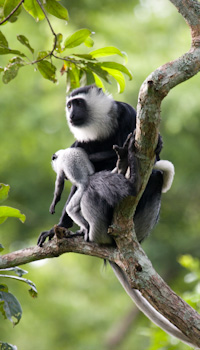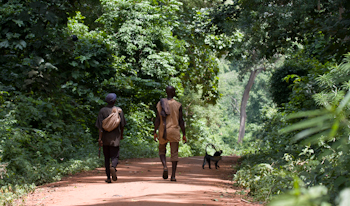Research
Primate behavioural ecologyMy primary research interests revolve around social processes underlying group formation and group maintenance in primates. I am thus interested in investigating questions that relate to social relationships, mate choice, dispersal patterns, kinship and how these relate to each other. My earlier research was concerned with the effect of male reproductive competition on male-female relationships in mountain gorillas. Since 2000, I have led a research team working on Colobus vellerosus at the Boabeng Fiema Monkey Sanctuary in Central Ghana. We have described the natural history of this black and white colobus, its diet, its social and mating system. In doing so, we try to answer questions such as: how does diet influence social relationships in colobus monkeys? What influences male and female dispersal decisions? In what type of group should individuals, males or females, prefer to live? What influences group membership? How does reproductive competition play out in this species? |
 |
||
 |
Community-based conservationBy virtue of working with wild primates, I am also interested in conservation issues. Boabeng Fiema Monkey Sanctuary is a remarkable place, quite unique in West Africa. Indeed, this is a place where the monkeys are protected from hunting by traditional taboos, and where the communities are involved in the management of the Sanctuary. This makes it an interesting situation to examine questions of traditional conservation practices, and community-based conservation. Several of my students have been involved in censusing the colobus population, and in tracking the changes in forest cover in the area over time. |
||
Study speciesThe genus Colobus is found in Africa. C. vellerosus (the ursine colobus, or white-thighed colobus) is one of the five species of black and white colobus. It is an arboreal, black–bodied monkey with long, white, slightly tufted tail. The face is encircled by a broad white ruff. The infants are born pure white, and acquire the typical adult black and white coat between three and four months of age. Researchers are able to recognize individuals based on variation in the shape of the band of hair above the eyebrows. The population of colobus at BFMS has grown consistently since the 1990s. It is probably the only growing population of Colobus vellerosus in its range in West Africa. The species is listed as vulnerable on the IUCN Red List. |
 |
||
A few of our findings so far:
|
|||
 |
|||
| My research at BFMS is NSERC funded. | |||
.

